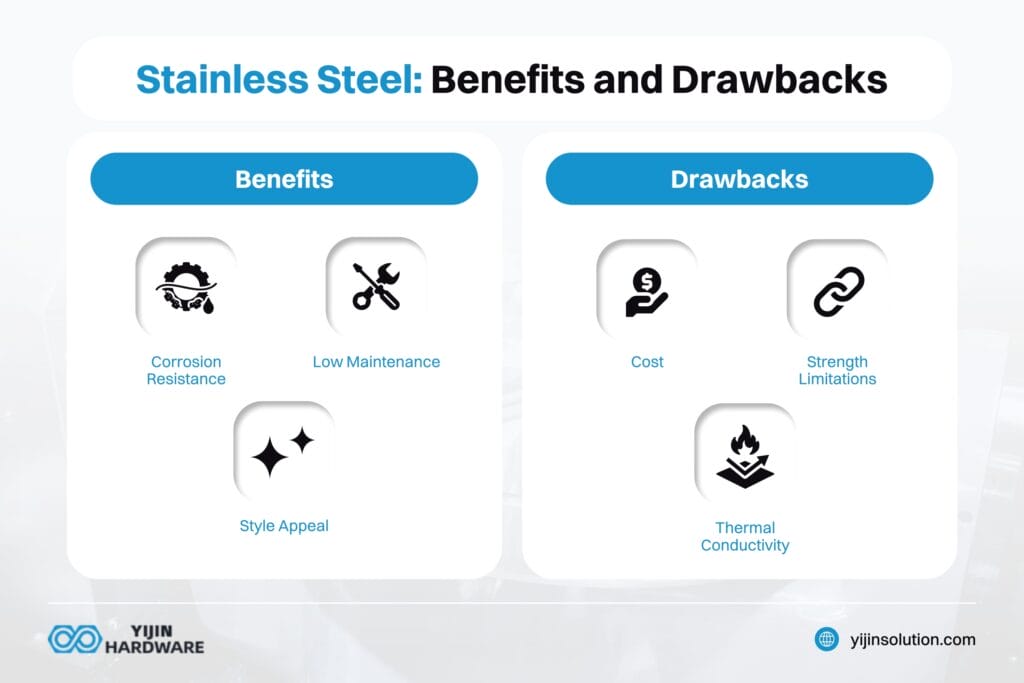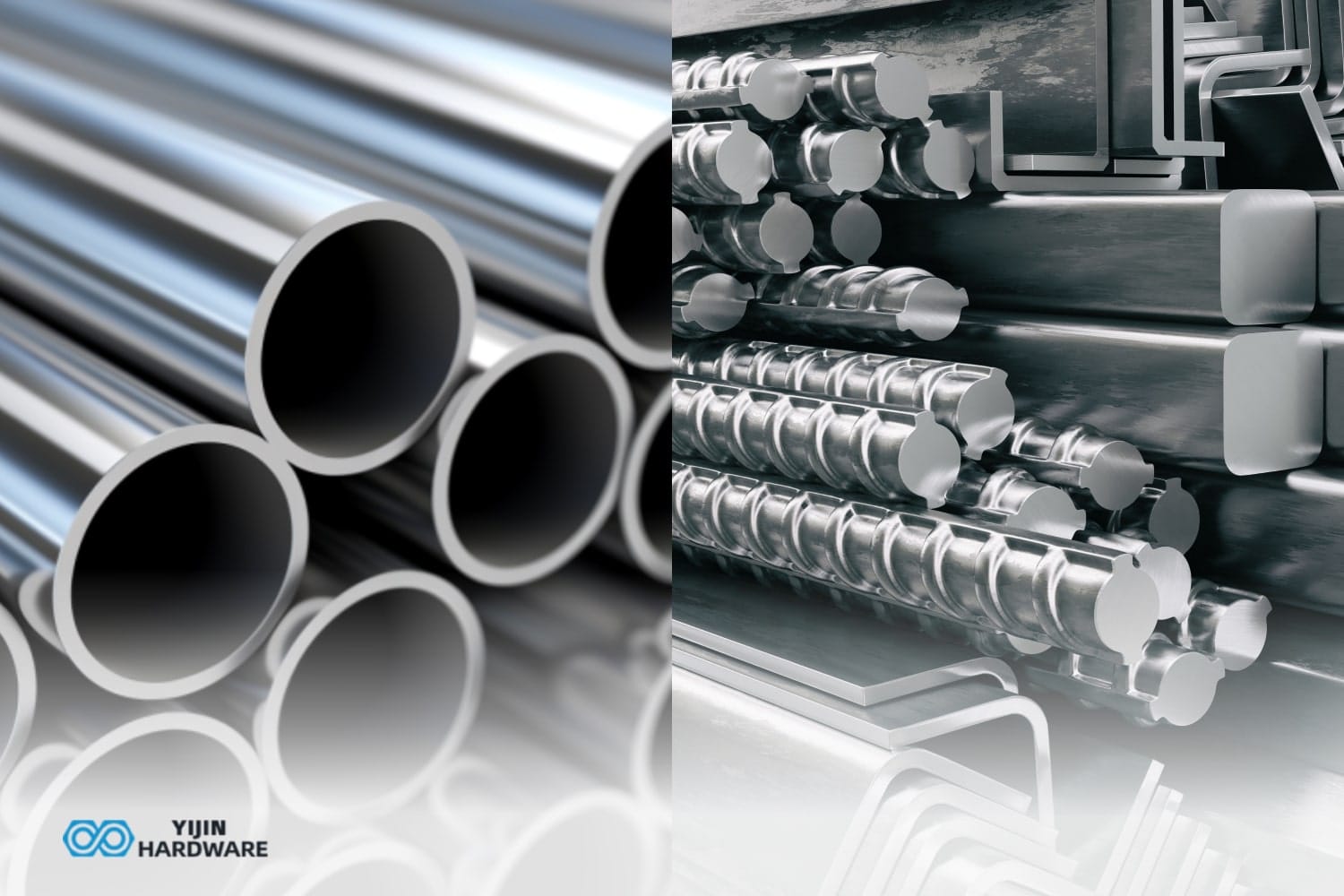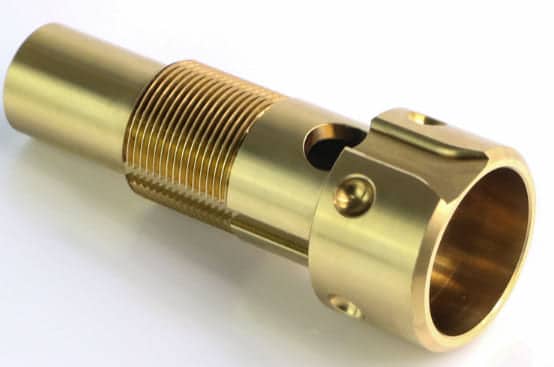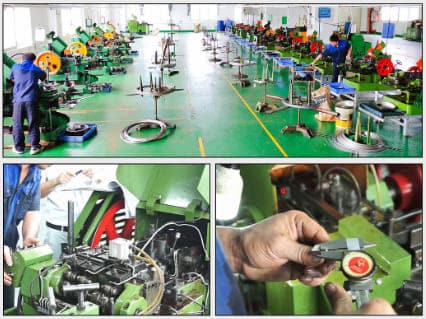Both alloy steel and stainless steel are important materials for a variety of applications, but you might be struggling to choose between the two. Both types of steel are often used in industries like construction and manufacturing, but they are only suitable for specific purposes. The wrong choice can lead to some costly consequences for you!
At Yijin Hardware, we want to make sure you use the right steel for your project. Here’s our alloy steel vs. stainless steel comparison to help guide you in the right direction.
Key Takeaways
- Alloy steel has high strength, while stainless steel excels when it comes to corrosion resistance.
- The choice between these two types of steel depends on your application, budget, and environmental conditions.
- Alloy steels require protective coatings against rust, but stainless steels offer low-maintenance solutions.
- Both materials play important roles across many industries, like construction and health care.
What is Alloy Steel?
Alloy steel is a specific kind of steel, containing iron and carbon, along with a few other alloying elements such as chromium, nickel, molybdenum, vanadium, and manganese. These elements can be added in different proportions to improve specific properties like toughness, hardness, strength, and wear resistance.
The exact composition of this steel type can vary a lot based on the traits and intended application. Alloy steel is known for its versatility and ability to be custom-made for specific uses. This makes it a very popular choice in many industrial applications.
Types of Alloy Steel
Alloy steels can be broken up into a few different groups based on their composition:
- Low-Alloy Steel: This steel is an alloy that has up to 5% alloying elements. When compared to carbon steel, it has superior mechanical properties, and it is frequently employed in construction and manufacturing.
- High-Alloy Steel: This steel has more than 5% alloying elements. This category includes tool steels and maraging steels, which are popular because of their high strength and toughness.
- Tool Steel: This steel is designed for making tools and dies due to its strength and hardness, as well as wear resistance.
Benefits of Alloy Steel

- High Strength and Hardness: Alloy steels usually have great tensile strength due to their microstructure, making them a good option for heavy-duty applications. For manufacturing parts from alloy steel with precision and durability, many industries rely on specialized CNC machining solutions from China to ensure consistent quality.
- Cost-Effective: Alloy steel is typically less expensive than stainless steel, so it’s a cost-effective solution for many industrial uses.
- Versatility: The properties of alloy steel can be changed by adjusting the type and amount of alloying elements.
Drawbacks of Alloy Steel
- Corrosion Resistance: Alloy steel is more vulnerable to corrosion compared to stainless steel. It generally needs protective coatings or treatments.
- Maintenance: Alloy steel has higher maintenance requirements because of its susceptibility to rust. This can increase overall costs.
- Weldability: Some types of alloy steel can be hard to weld because they have complicated compositions.
What is Stainless Steel?
Stainless steel is an alloy that mainly consists of iron with at least 10.5% chromium content. The chromium creates a passive oxide layer on the surface that ensures excellent corrosion resistance.
Besides chromium, steel may have other elements like nickel, molybdenum, and nitrogen to improve its properties. This special composition makes stainless steel a great choice for applications where preventing rust is essential.
Types of Stainless Steel
Stainless steel can be grouped into different types based on its microstructure:
- Austenitic Stainless Steel: This steel has high levels of nickel and chromium. It offers great corrosion resistance and is non-magnetic.
- Martensitic Stainless Steel: Martensitic steel has a higher level of carbon content. It is popular because of its high strength and hardness, but it has lower corrosion resistance.
- Ferritic Stainless Steel: This steel has lower amounts of nickel but higher chromium levels. It is magnetic and has good corrosion resistance, but lower strength than austenitic types.
- Duplex Stainless Steel: This steel combines austenitic and ferritic structures for much higher strength and increased corrosion resistance.
Benefits of Stainless Steel

- Corrosion Resistance: Because of its high chromium content, stainless steel has a powerful resistance to rust and corrosion, so you can use stainless steel in various environments.
- Low Maintenance: Basic stainless steel material does not need much maintenance to keep its appearance and structural integrity.
- Style Appeal: Stainless steel is a sleek material, with a modern look. It is known to be aesthetically pleasing, which is why stainless steel is popular in architecture and design applications.
Drawbacks of Stainless Steel
- Cost: Stainless steel is typically more expensive than alloy steel because of the cost of alloying elements like chromium and nickel.
- Strength Limitations: While pretty strong, stainless steel does not commonly match the tensile strength of certain types of alloy steel.
- Thermal Conductivity: Stainless steel typically has low thermal conductivity compared to most alloy steels, which can be a disadvantage in heat-related applications.
Alloy vs. Stainless Steel: Main Differences
Now, let’s talk about the main differences between alloy and stainless steel! Here’s how they compare:
Applications
Alloy steels are often used in industries that require high-strength materials, like construction, automotive, and energy. You’ll frequently find alloy steel in beams, girders, crankshafts, gears, and pipelines.
Stainless steel, on the other hand, is better for environments where corrosion resistance is paramount, such as in kitchenware, medical instruments, and architectural elements. Typical examples include cookware, utensils, surgical tools, handrails, and facades.
Strength
Alloy steels generally have higher strength compared to stainless steels because of their custom compositions, such as the alloy of iron and carbon. This makes them best for heavy-duty applications where high tensile strength is important.
On the other hand, stainless steel is still strong enough for many applications, but in most environments it cannot beat the strength of many alloys.
Chemical Composition
The chemical composition has a huge effect on the properties of both types of steel. Alloy steel usually has iron with different amounts of carbon steel (up to 2%), as well as other elements like manganese or molybdenum.
Stainless steel contains at least 10.5% chromium with different amounts of nickel or molybdenum depending on the specific stainless steel grade (for example, 316L or 304 stainless steel).
Corrosion Resistance
Stainless steel ranks higher in corrosion resistance because of its chromium content, which creates a powerful protective layer against rust. On the other hand, while some alloy steel includes corrosion resistance because of extra alloys like chromium or nickel, they generally need protective coatings or treatments in corrosive environments to outperform materials like carbon steel.
Thermal Conductibility
Thermal conductivity can be an important part of your application. Alloy steels tend to have higher thermal conductivity compared to stainless steels. These properties make alloy steels a better choice for applications involving heat transfer or dissipation.
Yijin Hardware: CNC Machining Experts
Both alloy steel and stainless steel are great materials, but your choice depends on your application and personal preferences. If you need steel for heavy-duty applications, alloy steel is typically the superior choice. In contrast, if you’re looking for extra corrosion resistance and a great aesthetic finish, stainless steel would generally be ideal.
If you need some help choosing the perfect steel for your project, reach out to Yijin Hardware. We are CNC machining experts ready to take on any project, big or small!
Alloy Steel vs. Stainless Steel FAQs
What grade is alloy steel?
There are many grades of alloy steel, but the most common are 4130, 4140, 4340, and 8620. 4130 is usually found in the aerospace industry, while 4140 is often used to manufacture large equipment.
Is alloy good for jewelry?
Yes, alloy can be a good quality choice for jewelry, but if you have a metal allergy or sensitive skin, it’s best to avoid metal and alloys altogether. You could opt for specific nickel-free alloys or stainless steels like 316L, which are considered hypoallergenic.
Which to choose between alloy steel vs. stainless steel knife?
Stainless steel is typically preferred for chef knives, rather than alloy. This is because it has a wide variety of grade options for different purposes, and it is affordable. It’s worth noting that your preferences will determine the best choice. Indeed, professional chefs often prefer carbon steel knives for their superior edge retention and sharpness, while stainless steel is popular for kitchen knives due to its corrosion resistance.
Back to Top: Alloy Steel vs. Stainless Steel

 info@yijinsolution.com
info@yijinsolution.com (+86) 188-2253-7569
(+86) 188-2253-7569







